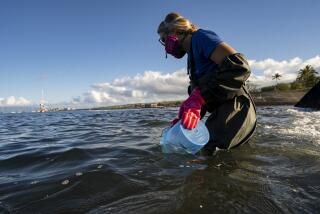Flaming river redux: Fire erupts from polluted froth on India lake

Last month, small orange flames flickered on Bellandur Lake’s surface amid the toxic suds.
Mohamed Attaulla Khan won’t forget the night the lake he used to fish on as a boy caught fire.
The pollution in Bellandur Lake was well-known: Every summer for more than a decade, a white froth as thick as shaving cream had carpeted the water, a chemical reaction caused by untreated waste. But standing on a bridge one evening last month, Khan, a 56-year-old high school principal, saw small orange flames flickering at the lake’s surface amid the toxic suds.
As he leaned over the railing, a breeze slammed into his face with fumes from the water. It felt hot and smelled of sulfur, Khan recalled, and within minutes, his left eye began to itch and swell. Doctors diagnosed him with a ruptured cornea, related to the fumes.
The fires caused no structural damage and subsided after a few days, but they underscored the environmental costs of the explosive growth in Bangalore, India’s high-tech hub, which, like many Indian cities, is choking from illegal construction, unregulated dumping, official mismanagement and mounting waste.
Some have drawn comparisons to Cleveland’s Cuyahoga River, which was so thick with oil slicks and industrial pollution that it caught fire multiple times through the 1960s — and as a result, is credited with helping to inspire the U.S. environmental movement.
Green activists in India hope the Bellandur fire will prompt a similar reckoning.
“It’s not every day that a lake catches fire,” Khan said. “This should make people wake up and realize that we have a serious problem.”
In a report submitted to authorities in early June, T.V. Ramachandra, one of the city’s leading environmental scientists, said the foam in the water was the result of “sustained inflow of untreated sewage and effluents,” which rainfall and high winds churn into froth. A cigarette tossed into the lake could cause the foam to ignite, he said.
For years, Ramachandra and other scientists have warned of severe degradation in a place once known as the “City of a Thousand Lakes.” Most were built five centuries ago to supply irrigation and drinking water to a landlocked population and later were connected by a canal system under British rule.
Over the past two decades, Bangalore’s population doubled to nearly 10 million as the city evolved into an Indian version of Silicon Valley, but local agencies failed to manage the growth. Compared to 1973, the developed area of the city has increased ninefold while bodies of water have shrunk by 80%, Ramachandra says.
As the demand for land increased, developers built bus stations, stadiums, high-rise apartment buildings and even a golf course atop dying lakes and the wetlands that once acted as natural purifiers. Much of the construction was illegal, driven by a powerful “land mafia” and abetted by corrupt local officials who looked the other way as debris and waste were dumped from homes and industries that lacked proper treatment systems.
A task force appointed by the government of Karnataka state, which includes Bangalore, reported in 2011 that the city had become “a land of a thousand sewage tanks.”
“Because regulatory agencies are weak and don’t have much power or staff, all the polluters are taking advantage,” Ramachandra said in an interview. “For the last four decades, we are paying the price.”
The annual appearance of the white foam is a symptom of the larger problem, activists say. Bellandur lies near the southern end of the chain of lakes and receives more than 130 million gallons per day of untreated or partially treated sewage from homes and industries across the city, far more than it can filter naturally.
Scientists say the wastewater also contains detergents that are high in phosphorous, used by Indian manufacturers to soften hard water. That also contributes to the foam. The United States began restricting the use of phosphates in detergents in the 1970s after finding they were killing off aquatic life in the Great Lakes, but India has no such regulations.
This year, many Bangalore residents said, the foam on Bellandur and neighboring Varthur Lake was thicker and smellier than in previous years. The winds that swirl through the city ahead of the annual monsoon rains blew the froth into the streets, where it collided with vehicles and pedestrians, who at times struggled to pick it off their skin.
Ramachandra spent an hour with his students from the Indian Institute of Science, Bangalore, collecting samples of the foam one afternoon, and nearly all of them developed rashes, he said. It is worse for those living next to the lake, such as M. Manjunath, an unemployed father of a baby girl, who blamed the noxious froth for occasional headaches and dizziness.
“It has become very difficult here,” Manjunath said. He acknowledged that his neighbors in the shanties by the lakeside discarded their waste into the water, blocking a canal that caused the lather to build up in Bellandur Lake.
For years, ninth-grade science students from Khan’s high school have been studying the impact of the pollution in Varthur Lake and sending environmental samples to Ramachandra’s lab for testing. They have found e. coli bacteria in borewells fed by the lake — which residents use for drinking — and learned from doctors in the area that nearly half their patients are suffering from stomach ailments that activists say are linked to dirty water.
Samples the students took from Varthur Lake also have revealed high levels of oil and other hydrocarbons. Scientists and officials say that hydrocarbon-rich industrial waste, floating on the water and mixing with the lather, was what burst into flames beginning May 15.
“Industries have mushroomed in the area with no controls or regulations,” said Subhash Adi, the state upa lokayukta, or anti-corruption ombudsman, who has held hearings on the issue. “We’ve told the authorities there has to be action, and if they fail to do something, we will hold them responsible.”
But the hodgepodge of state and municipal agencies that share responsibility for the lakes has not identified the polluters. Instead, the agencies blamed one another as the fires made national headlines.
The Karnataka State Pollution Control Board said it would file suit against the Bangalore Water Supply and Sewerage Board for failing to stop the contamination. The sewage board said it was the pollution authority’s responsibility to find and cite those responsible for the illegal dumping.
The sewage board has asked for $156 million to set up new treatment plants on Bellandur and Varthur lakes. Local authorities are deep in debt and can’t afford to build them. Even if they could, researchers say that contaminants from scores of upstream lakes would continue to flow south, neutralizing the impact.
Residents say they have little faith in the government’s ability to solve the problem.
“We need to change course, but it’s like trying to turn the Titanic around,” said Nagesh Aras, a software executive and environmental activist. “There’s an iceberg ahead, but the captain hasn’t even seen it. And that’s the tragedy with the fires. We’re trying to explain that they’re just the tip of the iceberg.”
Twitter: @SBengali
More to Read
Start your day right
Sign up for Essential California for news, features and recommendations from the L.A. Times and beyond in your inbox six days a week.
You may occasionally receive promotional content from the Los Angeles Times.







